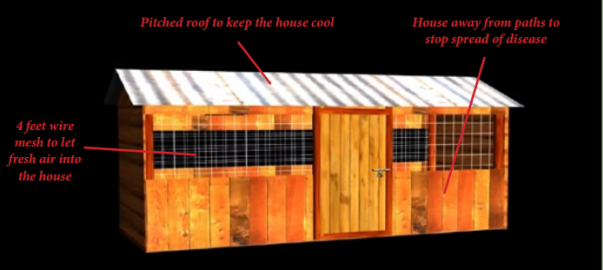Constructing a kienyeji chicken house is one of the most intriguing steps for many first-time farmers but it doesn’t have to be rocket science. There are only a few critical areas that you need to keep mind in order to get it right.

Failure to do always carries detrimental consequences. Some of the poultry diseases that you will have to grapple with a few months down the line are due to poor housing. The kind of house that you build and the quality of the biosecurity measures that you apply will play a major role in preventing or allowing the entry of diseases into the poultry house.
The Ideal Kienyeji Chicken House
- The first thing that you need to get right when constructing a poultry house is the house orientation. This should be in the east-west orientation. This kind of orientation will ensure that the house gets adequate sunshine. Lighting is important for many reasons. In the poultry house with lots of layers, it will help stimulate ovulation and trigger a more prolific laying performance. The light is also important for optimal feeding. Chicken feed well when there is a lot of light and they are also able to easily spot the feeders and drinkers.
- The solid height of the poultry house from the ground up should be 3 feet (1m) while the height from the floor to the roof should be 7 feet at a minimum. Two sides of the poultry house should be covered in a wire mesh while the two sides facing east and west should have a solid wall cover.
- Build the floor of the poultry house using concrete for ease of cleaning. This will also prevent dampness in the kienyeji chicken house as this is one of the main pathways through which diseases enter the poultry house.
- Have a foot dip with a disinfectant at the entrance of the chicken house or chicken run if the chickens are free ranging. This will help in stopping lots of diseases from entering the poultry farm.
- Have the right stocking density for the poultry house: Before you embark on the construction of the poultry house, you should have an idea on the stocking density that you would wish to have for your farm. For layers, the ideal stocking density is 2 square feet for the bird. The ideal stocking density for broilers or kienyeji chickens is 1 square feet per bird. If you are planning to keep 500 kienyeji chickens, the kienyeji chicken house should measure 500 square feet or 25feet by 20 feet or 30 feet by 17 feet.
- Have efficient storage for your poultry feeds that is rodent-proof. Rodents and wild birds can pass some diseases to your chickens.